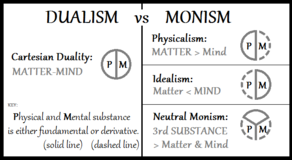Theory associated primarily with William James(1842-1910), who named it, and Bertrand Russell(1872-1970); though it has affinities to the views of Ernst Mach (1838-1916), Henri Bergson (1859-1941) and others.
Neutral monism says that mind and matter can both be reduced to a single type of thing, sometimes called ‘neutral stuff’.
This took the form of sensations or experiences, which constituted minds if thought of as arranged in one way, and matter if in another.
Source:
B Russell, The Analysis of Mind (1921)
Relations to other theories

A diagram showing the relationship between neutral monism and three other philosophical theories.
Physicalists believe reality is fundamentally material, idealists believe reality is fundamentally mental, dualists believe reality consists of both fundamentally mental and fundamentally physical elements, and neutral monists believe reality consists of elements that are neither fundamentally physical nor mental.[2]
Monism
Neutral monism largely overlaps with dual-aspect theory. However, it shares little in common with other forms of monism, such as idealism and physicalism.[citation needed]
Dualism
Neutral monism is similar to dualism in that both take reality to have both mental and physical properties irreducible to one another. Unlike dualism however, neutral monism does not take these properties to be fundamental or separate from one another from any meaningful sense.[3] Dualism takes the mind to supervene on matter, or – though this is less common – for matter to supervene on the mind. Neutral monism, in contrast, take both mind and matter to supervene on a neutral third substance. According to Baruch Spinoza, the mind and the body are dual aspects of Nature or God, which he identified as the third substance.[4]
While schematic differences and neutral monism are quite stark, contemporary conceptions of the theories overlap in certain key areas. For instance, Chalmers (1996) maintains that the difference between neutral monism and his preferred property dualism can, at times, be mostly semantic.[5]
Panpsychism
Panpsychism is a class of theories that believe consciousness is ubiquitous. John Searle distinguished it from neutral monism as well as property dualism, which he identified as a form of dualism.[6] However, some neutral monist theories are panpsychist and some panpsychist theories are neutral monist. However, the two don’t always overlap. For instance, Russellian monism is not panpsychism in response to the combination problem. Conversely, some versions of property dualism are panpsychist, but not neutral monistic.[citation needed]
History
Early 20th century
Neutral monism about the mind–body relationship is described by C. D. Broad in one of his earlier works, The Mind and Its Place in Nature. Broad’s list of possible views about the mind-body problem, which became known simply as “Broad’s famous list of 1925” (see chapter XIV of Broad’s book)[7] states the basis of what this theory had been and was to become. Some examples of philosophers who are seen to have a neutral monist view are Baruch Spinoza, David Hume, Roberto Ardigò, Ernst Mach, Richard Avenarius, Kenneth Sayre, Joseph Petzoldt and Jonathan Westphal.[citation needed] There are few self-proclaimed neutral monists. Most who are regarded as of this view were classified as such after their deaths.
Earlier, William James had propounded the notion in his essay “Does Consciousness Exist?” in 1904 (reprinted in Essays in Radical Empiricism in 1912).[8] Whately Carington in his book Matter, Mind, and Meaning (1949) advocated a form of neutral monism. He held that mind and matter both consist of the same kind of components known as “cognita” or sense data.[9][10][11] Russian psychologist Boris Sidis also appears to have adhered to some form of neutral monism.[12] William James was one of the earliest philosophers to fully articulate a complete neutral monist view of the world. He did so largely in reaction to neo-Kantianism, which was prevalent at the time.[13]
Bertrand Russell is perhaps the best known advocate of neutral monism. Russell expressed interest in neutral monism early on his career, and officially endorsed the view from 1919 onward. He has hailed the ontology as the “supreme maxim in scientific philosophising”. Russell’s conception of neutral monism went through a number of iterations throughout his career.[13][3] Russell’s personal brand of neutral can be referred to as Russell’s neutral monism or Russellian monism. It is compatible with logical atomism, which was identified as Russel’s earlier philosophy until he changed it into “neutral monism”.[14] G.E Moore maintained that neutral monism such as Russell’s philosophy is flawed due to a misinterpretation of facts (e.g. the concept of acquaintance).[15]
Present
David Chalmers[16] has been known to express sympathy toward neutral monism. In The Conscious Mind (1996) he concludes that facts about consciousness are “further facts about our world” and that there ought to be more to reality than just the physical. He then goes on to engage with a Platonic rendition of neutral monism that holds information as fundamental. Though Chalmers believes neutral monism and panpsychism ought to be taken seriously, he considers the combination problem to be point of concern. He considers Russell’s solution of “protophenominal properties” to be ad hoc, and thinks such speculation undercuts the parsimony that made neutral monism initially appealing.
According to Stephen Stich and Ted Warfield, neutral monism has not been a popular view in philosophy as it is difficult to develop or understand the nature of the neutral elements.[17] Nevertheless, a Machian version of the view has been defended by Jonathan Westphal in The Mind-Body Problem, 2016

Some times its a pain in the ass to read what website owners wrote but this site is very user friendly! .
What’s up all, here every person is sharing these knowledge, thus it’s fastidious to read this webpage, and I used to go to see this blog every day.|